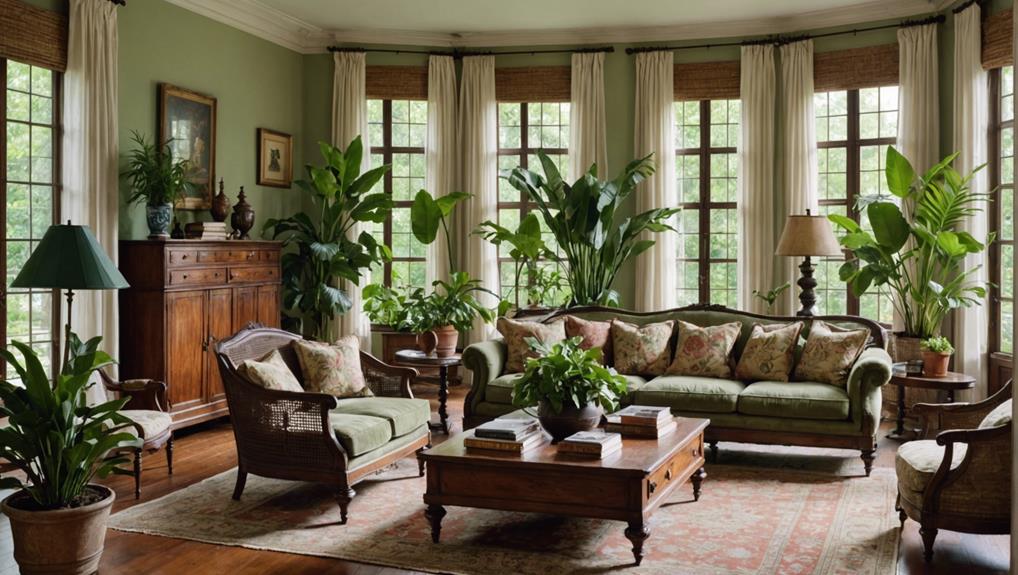
Creating a British Colonial Living Room: Step-by-Step Guide
Creating a British Colonial living room begins with understanding its core elements. Use a balanced color palette featuring light hues, such as Extra White and Irish Cream, complemented by dark timber floors. Select furniture in rich woods like teak and rattan, incorporating pieces with antique significance. Accentuate with blue and white ginger jars, adding visual interest. Layer textures with animal hides, woven mats, and Turkish rugs for an eclectic charm. Illuminate with chandeliers and lanterns that blend function with historical aesthetics. Finish with botanical prints and vintage mirrors for an expansive and inviting space. Discover the details to perfect these steps seamlessly.
Key Takeaways
- Choose a color palette with light hues and dark timber floors for contrast and richness.
- Invest in authentic wood furniture made of teak, mahogany, or bamboo for durability and elegance.
- Incorporate wicker and rattan elements in chairs and tables for texture and colonial charm.
- Decorate with blue and white ginger jars and tropical plants for an exotic touch.
- Accessorize with antique finds, botanical prints, and vintage mirrors for historical authenticity.
Understanding British Colonial Style
Originating during the British Empire's reign, British Colonial style artfully blends the elegance of English sophistication with the exotic allure of island life. This distinctive design emerged as British expatriates integrated traditional elements from their homeland with the local materials and aesthetics of their tropical surroundings. British Colonial influences are evident in the use of rich, durable woods like teak and rattan, which were both abundant and resilient to the humid climates of the colonies.
Exploring the historical context, one can see how high ceilings, oversized fans, and louvered doors were essential for maintaining airflow and comfort in the tropical heat. Architectural features such as symmetrical front doors and grid-like windows provided a sense of order and refinement, marrying practicality with aesthetic appeal. The overall ambiance created is one of tranquility and relaxation, evoking a sophisticated yet well-traveled feel.
In modern interpretations of British Colonial style, these traditional elements are often preserved, yet adapted to contemporary tastes. Designers today might incorporate modern materials and technologies while maintaining the essence of the original style. This balance between historical authenticity and modern convenience makes British Colonial interiors timeless and inviting.
Choosing a Color Palette
Selecting the right color palette is essential for achieving an authentic and sophisticated British Colonial living room. Begin by choosing complementary tones that evoke the elegance and heritage of this classic style. A harmonious blend of shades such as Extra White, Mesa Tan, and Irish Cream can create a serene and inviting atmosphere. These light hues provide a subtle backdrop that allows other design elements to shine.
Pairing these lighter walls with dark timber floors creates a striking contrast that is characteristic of the British Colonial aesthetic. Exploring different shades of Polished Mahogany can add depth and richness to the space, reflecting the traditional dark wood furniture commonly associated with this style. This deep, warm hue can be balanced with lighter fabrics, ensuring the room remains airy and sophisticated.
Incorporating Smokey Topaz can further enhance the warmth and sophistication of the living room. This color can be used in accents or as a feature wall to add a touch of luxury.
Selecting Furniture Pieces
When selecting furniture for a British Colonial living room, focus on pieces made from dark stained teak, mahogany, or bamboo to evoke an authentic and sophisticated ambiance.
Enhance the aesthetic by incorporating wicker and rattan elements, such as cane bed heads and woven chairs, which add texture and a sense of tropical elegance.
These materials not only provide durability but also seamlessly blend luxury with the rustic charm characteristic of British Colonial design.
Choosing Authentic Wood Furniture
To achieve an authentic British Colonial living room, invest in wood furniture made from materials like mahogany, teak, or bamboo, each renowned for its durability and timeless elegance. These woods not only provide a foundation of strength and resilience but also contribute to the aesthetic richness synonymous with British Colonial design.
When selecting these furniture pieces, consider antique finds that carry historical significance and unique character. Vintage items often showcase the craftsmanship and intricate carvings typically associated with this style, offering a touch of authenticity that new pieces may lack.
Incorporating sustainable materials into your selection is equally vital. Opt for furniture crafted from responsibly sourced wood to make sure that your design choices align with eco-friendly practices. Look for pieces with clean lines and brass accents, which are hallmarks of British Colonial style.
Canopy beds, plantation chairs, and campaign furniture, such as chests of drawers or folding tables, can serve as focal points in your living room, adding both practical and historical elements. Each piece should be sturdy and well-crafted, emphasizing the natural beauty of the wood and contributing to an overall elegant and timeless atmosphere.
Incorporating Wicker and Rattan
Embodying the tropical essence of British Colonial design, wicker and rattan furniture pieces seamlessly infuse texture and warmth into the living room. When selecting furniture, consider the benefits and drawbacks of wicker vs. rattan.
Wicker, crafted from weaving various plant materials, offers intricate designs and a lightweight feel, perfect for creating a relaxed and inviting atmosphere. Conversely, rattan, derived from a specific type of palm, is known for its durability and natural finish, making it ideal for pieces that prioritize longevity.
Opt for chairs, tables, and sofas made from these materials to guarantee your living room exudes the desired tropical ambiance. Accent pieces such as side tables, planters, and baskets can further enhance cohesion and authenticity. For those looking to add a personal touch, DIY wicker decor provides creative ideas to incorporate unique elements into your space.
Consider crafting custom frames or weaving your own baskets to add an extra layer of texture and individuality. Intricate designs and natural finishes are paramount in maintaining the British Colonial aesthetic. Selecting the right combination of wicker and rattan furniture ensures a harmonious blend of functionality and style, essential for achieving an authentic and timeless living room.
Incorporating Teak and Rattan
Incorporating teak and rattan into your living room design serves as a cornerstone of British Colonial style, offering a blend of durability, elegance, and tropical charm. Teak furniture, known for its warmth and sophistication, often features intricate carvings and sturdy construction, making it a perfect choice for larger pieces like sofas and coffee tables. When considering Teak vs. Mahogany, teak's natural oils and dense grain provide superior durability and resistance to the elements, making it ideal for both indoor and outdoor settings.
Rattan accents, such as chairs and side tables, bring a touch of tropical charm to the space, creating a relaxed atmosphere that complements the more formal teak pieces. Understanding the difference between Rattan vs. Wicker is important; while rattan refers to the natural material used, wicker denotes the weaving process. This distinction helps you make informed choices about your decor.
To effectively incorporate teak and rattan into your British Colonial living room:
- Select a teak sofa or coffee table for a centerpiece that exudes warmth and sophistication.
- Add rattan chairs to introduce a relaxed, tropical feel.
- Mix teak and rattan side tables to balance elegance and charm.
- Use rattan accent pieces like baskets or planters to enhance the tropical ambiance.
Adding Blue and White Accents

Enhancing your British Colonial living room with blue and white accents introduces a timeless elegance that echoes the sophistication of exotic travels and colonial heritage. This classic color combination brings a sense of calm and refined beauty, perfectly complementing the tropical influences of the British Colonial style.
Incorporating a blue and white rug is one of the most effective styling tips for achieving this aesthetic. A meticulously chosen rug can anchor the room, adding a touch of exoticism that enhances the well-traveled feel of the space. Look for patterns that reflect traditional designs, such as floral or geometric motifs, to evoke an air of sophistication and history.
For additional design inspiration, consider integrating blue and white cushions and throws. These accents can effortlessly infuse a British Colonial aesthetic into your living room decor, creating a cohesive and harmonious look. Opt for high-quality fabrics with intricate patterns to add depth and texture.
Utilizing Ginger Jars
Utilizing ginger jars in your British Colonial living room adds a sophisticated touch of global influence and historical elegance. Originating from the Ming Dynasty in China and characterized by their distinctive blue and white color scheme, ginger jars have become a symbol of wealth, good fortune, and prosperity.
Here are some styling tips to seamlessly incorporate these timeless pieces into your decor:
- Groupings: Arrange ginger jars in groups of three or five on a mantelpiece or sideboard to create a focal point. Vary the sizes and shapes to add visual interest.
- Bookshelves: Place ginger jars amidst books and other decorative items on your shelves. This adds depth and a layer of historical context to your display.
- Table Centerpieces: Use a single large ginger jar as a centerpiece for your coffee or side table. Complement it with smaller decorative objects to balance the composition.
- Accent Corners: Position a pair of ginger jars on either side of a doorway or fireplace to frame the space and enhance the overall aesthetic.
To maintain their pristine condition, follow these care instructions: dust regularly with a soft, dry cloth and avoid direct sunlight to prevent fading. For a thorough clean, use a damp cloth with mild soap, ensuring to dry them completely to avoid water spots.
Integrating ginger jars into your British Colonial living room will unquestionably enrich its historical charm and global elegance.
Decorating With Tropical Plants
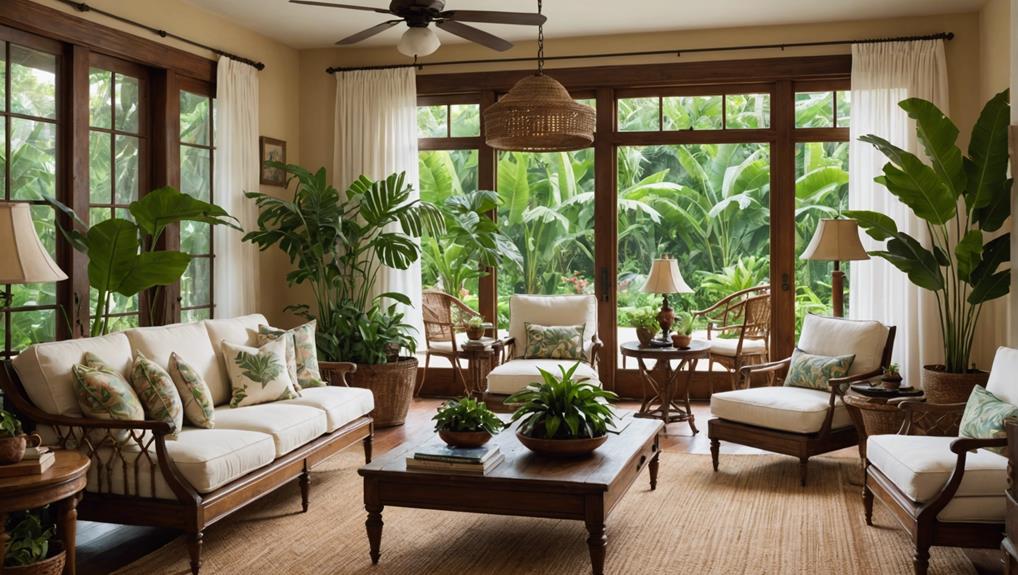
Tropical plants such as palms, monstera, and bird of paradise infuse a British Colonial living room with a lush, exotic ambiance that echoes the vibrancy of far-flung locales. These verdant elements are pivotal in recreating the warm, humid climates reminiscent of tropical regions. Embrace the natural textures of rattan or wicker baskets for plant placement, enhancing the colonial aesthetic seamlessly.
Incorporate a variety of plant sizes and shapes to introduce depth and visual interest. For instance, towering palms can be positioned in corners, while smaller monstera plants can be placed on side tables or in DIY planters. Hanging options such as ferns or trailing vines add vertical dimension, evoking a relaxed, island-inspired atmosphere.
| Plant Type | Placement | Care Tips |
|---|---|---|
| Palms | Corners | Moderate sunlight, moist soil |
| Monstera | Side tables, planters | Bright, indirect light, moist soil |
| Bird of Paradise | Near windows | Full sunlight, well-drained soil |
Proper care is essential for maintaining the lushness of these tropical plants. Regular watering, appropriate sunlight, and occasional misting help sustain their vibrant appearance. Integrating a mix of plant sizes and hanging options not only enhances the aesthetics but also creates a revitalizing, tropical sanctuary within your living room.
Incorporating Antiques
How can the timeless charm of antiques transform your British Colonial living room into a space rich with history and elegance? Incorporating antique treasures and vintage charm can enhance your space, creating an environment that feels both curated and storied. Key antique pieces serve as focal points, adding depth and authenticity to the room.
Consider the following to integrate antiques seamlessly:
- Furniture Selection: Opt for classic furniture pieces like teak chests, campaign desks, and mahogany tables. These items are not only functional but also embody the sophistication of the British Colonial era.
- Display Artifacts: Enhance the colonial feel by showcasing vintage artifacts. Brass binoculars, globe bar carts, and leather trunks are ideal choices that bring a touch of historical intrigue.
- Wall Decor: Antique mirrors, framed botanical prints, and colonial-era artwork can add layers of character to your walls. These items reflect the aesthetic sensibilities of the period and provide visual interest.
- Mixing Elements: Blend antique pieces with modern elements to create a well-traveled ambiance. This juxtaposition of old and new enriches the space, making it feel curated and cohesive.
Utilizing these strategies ensures your British Colonial living room is both elegant and evocative, filled with stories from the past.
Using Decorative Items
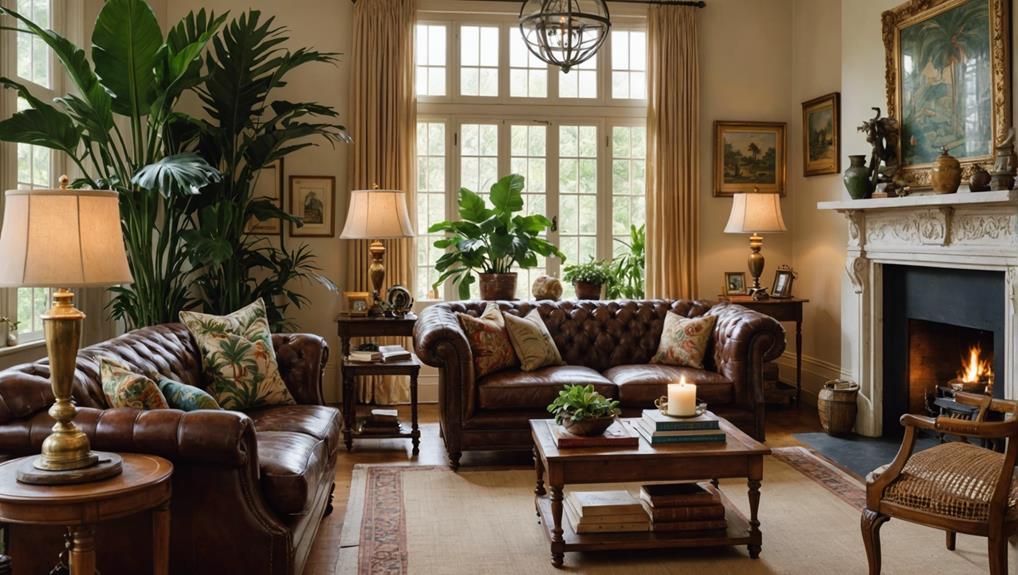
Incorporating carefully chosen decorative items is crucial for capturing the authentic charm and elegance of a British Colonial living room. Central to this aesthetic is the use of blue and white ginger jars, which offer a timeless appeal and serve as striking focal points. Pair these with a blue and white rug to not only ground the space but also enhance its exotic feel. This combination exemplifies the technique of mixing patterns, a hallmark of British Colonial design that brings visual interest and depth.
Layering textures is another crucial aspect to take into account. Displaying collectible artifacts, such as vintage bird cages and animal print rugs, adds an eclectic and worldly touch. These items evoke the sense of a well-traveled lifestyle, rich with stories and history. Complement these with vintage globes, writing boxes, and maps, which further emphasize the room's narrative of exploration and adventure.
For an authentic British Colonial ambiance, it's important to mix and match items imperfectly. This approach ensures the space feels curated yet relaxed, avoiding the overly polished look. Incorporating these decorative elements thoughtfully will make your living room a true reflection of British Colonial charm and sophistication.
Integrating Classic Accents
Building upon the carefully curated decorative items, integrating classic accents such as dark timber furniture, leather trunks, and rattan chairs is key to achieving an authentic British Colonial ambiance. These elements not only evoke the elegance of the era but also provide a robust foundation for mixing modern elements and sustainable materials.
- Dark Timber Furniture: Opt for pieces that showcase rich, deep hues and intricate craftsmanship. These furniture pieces serve as the backbone of the room, establishing a sense of timeless sophistication.
- Leather Trunks: Incorporate these as multifunctional items, both as storage solutions and coffee tables. Their weathered look adds a layer of historical charm and adventure.
- Rattan Chairs: Lightweight yet durable, rattan chairs contribute to the airy and relaxed atmosphere. Choose designs that blend seamlessly with modern aesthetics for a balanced look.
- Botanical Prints and Earthy Tones: Use these in your soft furnishings to introduce a tropical touch. Cushion covers, throw blankets, and rugs featuring local flora and fauna will enhance the exotic feel.
Integrating these classic accents effectively captures the essence of British Colonial design, while allowing room for modern and sustainable touches. The result is a living room that feels both timeless and relevant, blending the old-world charm with contemporary sensibilities.
Lighting Considerations

When curating the lighting for a British Colonial living room, the selection of metal candlesticks, chandeliers, and lanterns becomes paramount in achieving a rustic yet refined ambiance. Opting for finishes such as brushed chrome, pewter, or iron, these elements not only reflect the rural nature of Colonial style homes but also add a timeless elegance to the space.
To create an authentic Colonial ambiance, incorporating vintage lighting fixtures is essential. Metal candlesticks, with their classic and enduring appeal, can be strategically placed on mantelpieces or side tables, casting a warm and inviting glow. Chandeliers, ideally with intricate detailing and a slightly aged patina, serve as statement pieces that draw the eye upward, enhancing the room's vertical space and adding grandeur. Lanterns, either hanging or freestanding, evoke a sense of historical charm and can provide ambient or task lighting, depending on their placement.
The key to successful lighting in a British Colonial living room lies in the balance between form and function. By selecting fixtures that offer both aesthetic beauty and practical illumination, one can create a space that not only honors the traditional Colonial style but also feels inviting and lived-in.
Adding Textiles and Rugs
Integrating lush textiles and carefully selected rugs can greatly enhance the authenticity and visual appeal of a British Colonial living room. The blending of rich colors and exotic prints with traditional elements creates a mesmerizing and immersive environment.
Layering Textures: Combine different textures such as animal hides, woven mats, and natural fibers like seagrass or jute. This layering adds depth and dimension, transforming the space into a visually engaging retreat.
Mixing Patterns: Play with a mix of patterns to evoke the era's eclectic charm. Incorporate vibrant tropical prints in soft furnishings like cushions and curtains to introduce a touch of exoticism.
Exotic Prints and Rich Colors: Opt for Turkish or Persian rugs with intricate patterns and rich colors. These rugs anchor the space, adding warmth and a sense of history to the decor.
Layering Rugs: For an added layer of sophistication, consider layering rugs. A traditional Persian rug can be paired with a natural fiber rug, creating a unique and inviting look.
Wall Art and Mirrors
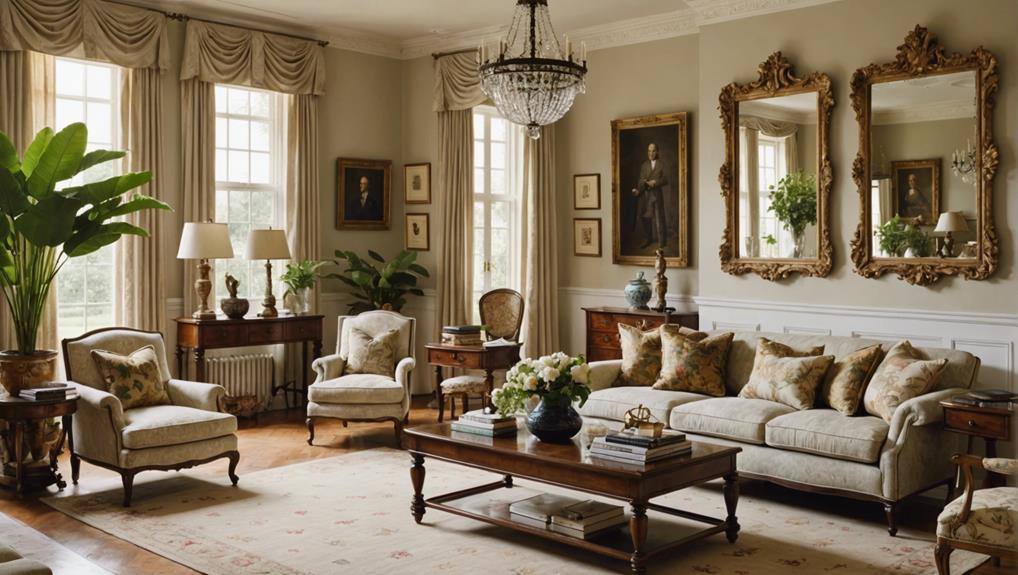
To further enrich the ambiance created by textiles and rugs, incorporating wall art and mirrors can greatly amplify the British Colonial aesthetic in your living room. Art placement is key to achieving this look. Botanical prints, vintage maps, and tropical paintings are essential choices that reflect the exploration and natural beauty central to British Colonial design. Arrange these vintage prints strategically to create a focal point or to complement the existing decor.
In addition to wall art, mirrors play an important role in enhancing the room's elegance and spaciousness. Opt for mirrors with intricate frames or brass finishes to add a touch of sophistication. Oversized mirrors are particularly effective in creating a sense of expansiveness and reflecting natural light, which is essential for the airy feel typical of British Colonial interiors. Antique or vintage mirrors can further enhance the historical and well-traveled ambiance.
Mixing and matching different sizes and styles of wall art and mirrors will lead to a curated and eclectic look. This approach not only imbues the room with visual interest but also pays homage to the varied influences and rich history that define the British Colonial style.
Final Touches for Cohesion
To achieve a cohesive British Colonial living room, begin by coordinating a balanced color palette that intertwines whites, earthy tones, and dark woods, ensuring a unified ambiance.
Accessorize with antiques such as brass candlesticks and decorative trunks to add authenticity and character.
Coordinating Color Palette
Selecting a cohesive color palette is essential for achieving the timeless elegance of a British Colonial living room. The foundation of this design style lies in a balanced interplay of soft whites, earthy tones, and rich mahogany. These hues not only establish a sophisticated ambiance but also provide a versatile backdrop for coordinating furniture pieces and choosing accent colors.
To guarantee your British Colonial living room exudes both harmony and visual interest, consider the following steps:
- Base Colors: Opt for light-colored walls and ceilings in shades of soft white or cream. These tones will enhance the room's airy feel and perfectly complement dark timber floors, creating a balanced atmosphere.
- Furniture Coordination: Choose furniture pieces in rich mahogany or dark wood finishes. This provides a striking contrast to the lighter walls and ties in the colonial aesthetic seamlessly.
- Accent Colors: Incorporate deep blues, greens, and warm yellows through textiles and decor. These colors add depth and vibrancy without overwhelming the space.
- Patterns and Motifs: Use botanical prints, animal motifs, and tropical patterns in cushions, drapes, and upholstery. These elements introduce texture and reinforce the colonial theme.
Accessorizing With Antiques
With the foundation of your British Colonial living room established through a cohesive color palette, attention to accessorizing with antiques will impart the final layers of character and historical charm.
Incorporating vintage treasures such as antique bird cages and animal print rugs infuses the space with an eclectic charm, reflecting the spirit of colonial exploration.
To enhance the well-traveled ambiance, display collections of globes, fine China, and vintage books. These items not only add aesthetic appeal but also evoke a sense of adventure and discovery.
Antique elegance can be achieved by incorporating blue and white ginger jars, which symbolize exotic travels and contribute a timeless appeal to the decor.
Mix and match these eclectic accessories to create an imperfect yet enchanting ambiance. A strategically placed vintage map can serve as a focal point, celebrating the era's cartographic achievements.
Complement the design with a blue and white rug to tie the room together, ensuring a cohesive look that resonates with British Colonial style.
Arranging Greenery Strategically
Strategically placing greenery throughout the living room will infuse your British Colonial design with vibrant, natural elements that enhance the room's tropical charm and cohesive aesthetic. Effective indoor gardening and plant decor can transform your space into a lush, inviting environment.
- Corners with Potted Palms or Ferns: Positioning potted palms or ferns in the corners of your living room adds verticality and a tropical touch. These plants provide a sense of height and lushness that aligns perfectly with British Colonial aesthetics.
- Cascading Vines on Shelves or Mantels: Hanging cascading vines or ivy on shelves or mantels introduces a lush, green look that softens hard lines and adds a touch of botanical elegance. This greenery arrangement creates visual interest and depth.
- Dramatic Oversized, Leafy Plants: Incorporate oversized, leafy plants such as banana or monstera for a dramatic effect. These plants anchor the room's design, providing focal points that draw the eye and reinforce the tropical theme.
- Fresh Flowers in Vases: Fresh flowers in brass or ceramic vases introduce pops of color and natural beauty. They serve as botanical accents that enhance the room's aesthetic while offering versatility in color and form.
Incorporating small succulents or air plants on side tables or wall shelves further adds modern botanical touches, ensuring a cohesive and vibrant living space.
Frequently Asked Questions
How to Create British Colonial Style?
To create a British Colonial style, select a color palette featuring neutral and earthy tones. Choose furniture crafted from dark woods like mahogany or teak, and incorporate lightweight fabrics, brass accents, and botanical prints for an elegant, tropical aesthetic.
How Do You Make a Room Look Colonial?
To achieve a colonial look, prioritize furniture selection with dark woods like mahogany. Opt for a color palette featuring whites, creams, and earth tones. Incorporate natural materials and exotic textiles, complemented by architectural details to enhance the aesthetic.
How Do I Decorate My Living Room Step by Step?
To decorate your living room step by step, start with a cohesive color palette of whites and neutrals. Focus on strategic furniture selection, including rattan chairs and leather trunks, complemented by botanical prints, brass lighting, and exotic textiles.
What Is British Colonial Style Architecture?
British Colonial style architecture, influenced by historical British Empire reign, blends island aesthetics with English refinement. Its cultural significance lies in utilizing local materials like teak and rattan, high ceilings, and tropical themes, creating a serene, elegant environment.
Conclusion
The creation of a British colonial living room necessitates a meticulous approach to design elements, including color palettes, furniture selection, and material incorporation.
Attention to teak and rattan, combined with blue and white accents, fosters an authentic aesthetic.
Thoughtful lighting choices and the addition of textiles, rugs, wall art, and mirrors enhance the visual appeal.
Ultimately, meticulous attention to these details guarantees a cohesive and historically resonant living space that embodies the elegance of British colonial style.
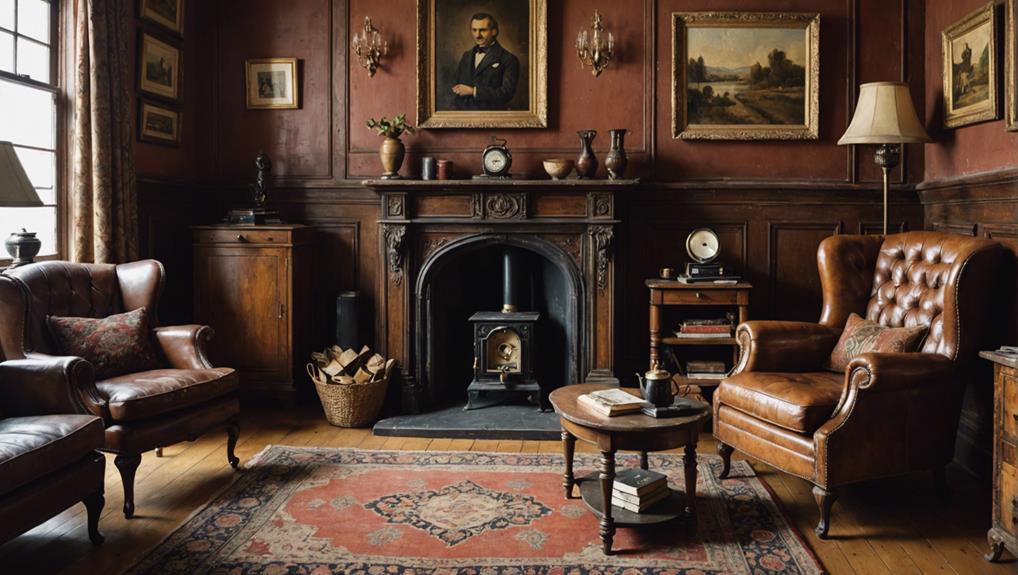
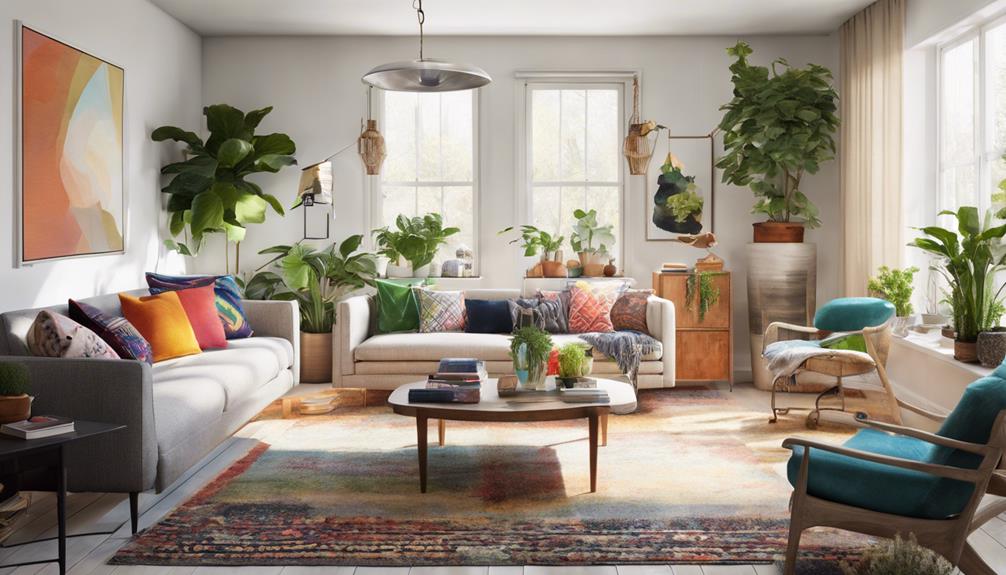
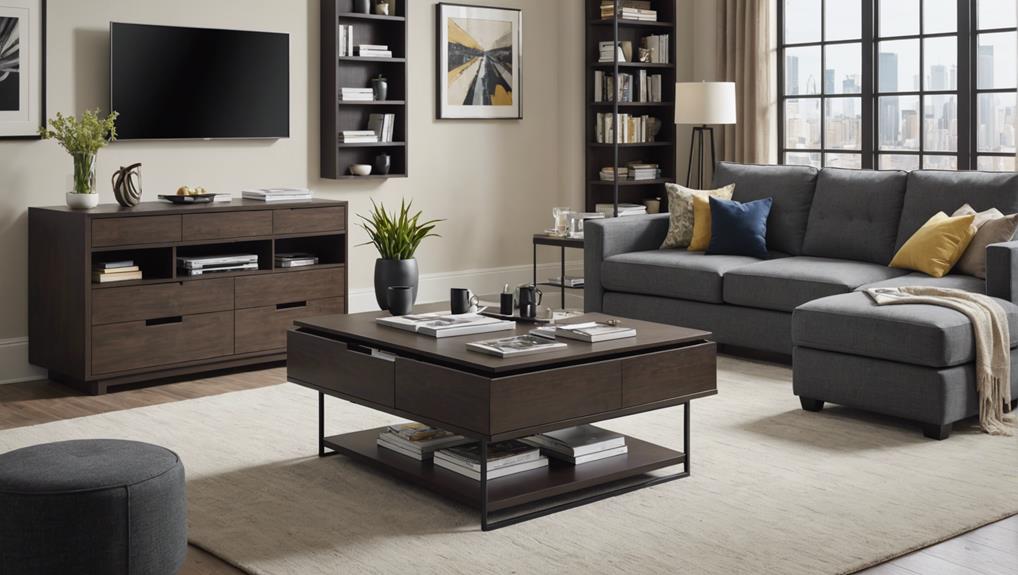
Leave a Reply